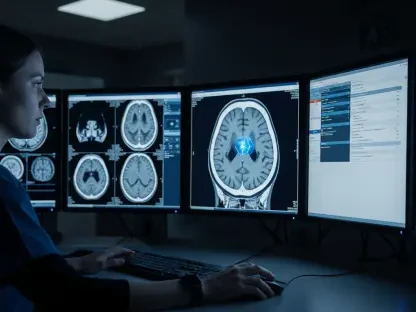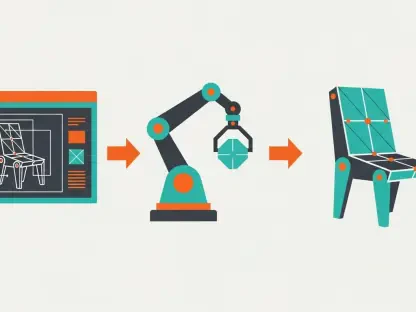Breast cancer remains a formidable global health crisis, impacting millions of lives with over 2.3 million new diagnoses and 670,000 deaths reported in recent global health data, underscoring the urgent need for improved detection methods. The key to enhancing survival rates lies in early detection, yet traditional screening methods often fail to deliver accurate results, especially for women with dense breast tissue where malignancies can be obscured. This critical gap in diagnostics has sparked a wave of innovation, positioning artificial intelligence (AI) and three-dimensional (3D) imaging as potential game-changers in the fight against this disease. Imagine a future where even the most elusive tumors are detected with precision, transforming patient outcomes through technology that sees beyond the limitations of current tools. With the breast imaging market projected to reach $9 billion by 2030, driven by rising cancer incidence and technological advancements, the stakes have never been higher. Companies across the industry are racing to develop solutions that could redefine how breast cancer is identified and managed, offering hope to countless individuals. This exploration delves into the challenges of existing methods, the promise of emerging technologies, and the innovators leading the charge in this vital area of healthcare.
Addressing a Critical Health Challenge
The staggering impact of breast cancer underscores an urgent need for more effective diagnostic tools, as millions face this diagnosis annually, with hundreds of thousands succumbing to the disease. Global health statistics paint a grim picture, emphasizing that early detection remains the most powerful weapon in improving survival chances. In the United States alone, nearly 317,000 new invasive cases are anticipated this year, highlighting the scale of the problem. However, the tools relied upon for screening often fall short, leaving many at risk of delayed or missed diagnoses. This persistent issue drives the demand for innovation in medical imaging, where the integration of advanced technologies could bridge the gap between current limitations and life-saving early intervention. The human toll of inadequate detection cannot be ignored, as every missed case represents a lost opportunity for timely treatment, pushing the healthcare industry to seek solutions that address these shortcomings comprehensively.
Dense breast tissue, a condition affecting roughly half of all women, presents a particularly daunting barrier to accurate detection. In traditional screening, overlapping tissue can mask potential malignancies, significantly reducing the effectiveness of standard methods. This challenge is not merely technical but deeply personal, as women with denser breasts often face heightened risks without reliable alternatives. The inability to see through such tissue often results in false negatives, fostering a critical need for technologies that can penetrate these obstacles with clarity. As awareness of this issue grows, so does the momentum behind developing diagnostic approaches that prioritize precision in even the most complex cases. The push for better tools is not just about improving statistics but about ensuring that every individual has access to care that could make a profound difference in their outcome.
Unpacking the Shortcomings of Conventional Screening
Traditional mammography, long considered the cornerstone of breast cancer screening, relies on two-dimensional imaging that struggles to provide clear results in many scenarios. Particularly in cases of dense breast tissue, lesions can blend seamlessly into surrounding structures, diminishing the test’s sensitivity and leaving dangerous abnormalities undetected. This inherent flaw poses a significant risk to patient health, as early-stage cancers may go unnoticed until they progress to more advanced, harder-to-treat stages. The limitations of this method are a well-documented concern in the medical community, prompting a reevaluation of how screening is conducted. Addressing these gaps is not just a matter of technological advancement but a moral imperative to protect vulnerable populations from the consequences of inadequate diagnostics.
Beyond issues of accuracy, the process of mammography itself introduces additional barriers to effective care. The physical compression required during the procedure can distort images, further complicating interpretation, while also causing significant discomfort for many patients. This unpleasant experience can deter individuals from adhering to regular screening schedules, exacerbating the risk of late detection. Moreover, the emotional toll of undergoing such a procedure, combined with the uncertainty of unreliable results, adds another layer of challenge. A more patient-friendly approach is desperately needed—one that balances diagnostic precision with comfort and accessibility. The drive to innovate in this space reflects a broader recognition that current methods must evolve to meet both clinical and human needs in a holistic manner.
Harnessing AI and 3D Imaging for Breakthroughs
The convergence of AI and 3D imaging technologies marks a transformative moment in the realm of medical diagnostics, offering a glimpse into a future of unparalleled accuracy. AI algorithms are engineered to enhance image quality by filtering out noise, boosting contrast, and detecting subtle abnormalities that might escape even the most trained human eyes. This capability serves as a powerful aid to radiologists, amplifying their ability to identify potential issues with confidence. When integrated with 3D imaging systems, such as tomosynthesis or dedicated breast CT, the result is a comprehensive, volumetric perspective of breast tissue that reveals details invisible in traditional flat images. This synergy holds immense promise for catching cancers at their earliest, most treatable stages, potentially reshaping the landscape of preventive care with tools that prioritize both depth and precision.
Safety and efficiency further distinguish this technological pairing as a step forward in patient-centered innovation. Studies have shown that AI can often match or surpass the diagnostic performance of expert radiologists, particularly in challenging cases involving dense tissue. This not only bolsters trust in the results but also supports workflows by streamlining the analysis process, allowing healthcare providers to focus on patient care rather than prolonged image interpretation. Additionally, advancements in 3D imaging contribute to reducing radiation doses compared to older methods, addressing longstanding concerns about exposure during screening. The potential of these tools lies not just in their technical prowess but in their ability to deliver results that are both reliable and considerate of patient well-being, paving the way for broader adoption in clinical settings.
Innovating with Izotropic Corporation’s Vision
Among the frontrunners in this technological shift is Izotropic Corporation, which has developed the IzoView Breast CT Imaging System to specifically target the challenges of dense breast imaging. Unlike conventional approaches, IzoView eliminates the need for painful compression, instead offering high-resolution 3D visuals that provide a clearer picture of internal structures. This system is tailored to address the unique needs of a significant portion of the population often underserved by standard screening tools. With a focus on enhancing contrast resolution, IzoView aims to uncover hidden abnormalities while maintaining a patient-friendly experience. Its design represents a bold step toward redefining how diagnostics are conducted, with an emphasis on accessibility for those at higher risk of missed diagnoses due to tissue density.
What sets IzoView apart is not just its imaging capabilities but also its strategic integration of AI and cost-effective scalability. The system employs a proprietary AI reconstruction algorithm, honed over years of specialized data collection, to produce detailed images at radiation levels comparable to traditional mammography. Priced at $500,000—a fraction of the $1.5 million cost of legacy breast CT systems—IzoView is positioned to reach a wider array of healthcare facilities, including smaller clinics. Izotropic envisions this technology as a complementary tool to existing modalities like MRI, with future aspirations to serve as a primary option in specific contexts. Its modular architecture also ensures adaptability to evolving clinical demands, making it a forward-looking investment in the fight against breast cancer.
Industry-Wide Push for Advanced Diagnostics
Izotropic is joined by other industry leaders in a collective effort to revolutionize breast cancer detection through cutting-edge solutions. Hologic Inc. has made significant strides with AI-powered mammography systems that excel at identifying aggressive cancers with a level of precision akin to expert analysis. This technology demonstrates how even established methods can be elevated through intelligent enhancements, offering radiologists a robust tool to improve screening outcomes. By focusing on integrating AI into widely used platforms, Hologic addresses the dual need for familiarity and innovation, ensuring that advancements are seamlessly woven into existing clinical practices. Their contributions highlight a broader trend of refining diagnostic accuracy while maintaining continuity in healthcare delivery.
Meanwhile, GE HealthCare Technologies Inc. brings its own innovation to the table with the Invenia Automated Breast Ultrasound (ABUS) Premium, leveraging AI to enhance detection in dense breast tissue where traditional imaging often falters. Nano-X Imaging Ltd. expands the reach of advanced imaging by deploying networks across diverse care settings, aiming to democratize access to state-of-the-art tools. Additionally, Oracle Corp. introduces CanvOI, a cloud-based AI model for oncology research that supports diagnostics through digital pathology. These varied approaches underscore a shared commitment across the sector to not only improve detection rates but also streamline clinical workflows and broaden the availability of life-saving technologies to patients worldwide, regardless of geographic or economic barriers.
Market Dynamics and Future Growth
The breast imaging market is on a steep upward trajectory, with projections estimating a climb to $9 billion by 2030, fueled by a combination of rising cancer incidence and rapid technological progress. This growth reflects a compound annual growth rate that signals robust investor interest and increasing clinical adoption of next-generation solutions. North America stands out as a key region driving this expansion, with supportive reimbursement policies and a strong emphasis on early detection programs. As healthcare systems grapple with escalating demand, the market’s evolution is shaped by the need for tools that can handle higher caseloads without sacrificing accuracy. This economic backdrop provides fertile ground for innovations that promise to transform diagnostics into a more efficient and effective process for providers and patients alike.
Segments like digital breast tomosynthesis (DBT) are expected to see particularly strong gains, with forecasts predicting a rise from $950 million in the current year to $1.71 billion by 2030. This surge is indicative of a broader shift toward 3D imaging modalities that offer superior visualization compared to older methods. The financial momentum in this space is not merely a reflection of market potential but also a testament to the pressing health challenges that these technologies aim to address. As clinical guidelines evolve to prioritize supplemental screening for high-risk groups, the demand for AI-enhanced and 3D imaging solutions is likely to intensify. This dynamic environment encourages continuous investment in research and development, ensuring that the next wave of diagnostic tools keeps pace with emerging needs.
Reflecting on a Path Forward
Looking back, the journey to enhance breast cancer detection through AI and 3D imaging reveals a landscape marked by both profound challenges and remarkable progress. The limitations of traditional mammography had long hindered effective care, particularly for those with dense breast tissue, but the emergence of advanced technologies offers a beacon of hope. Innovators like Izotropic Corporation, alongside industry giants such as Hologic and GE HealthCare, demonstrate that precision and patient comfort can coexist in diagnostic solutions. Their efforts underscore a pivotal shift toward intelligent systems that elevate human expertise with data-driven insights.
As this field moves ahead, the focus must remain on actionable steps to ensure these advancements reach those who need them most. Prioritizing regulatory pathways for swift approval of new tools, expanding access through affordable pricing models, and integrating these technologies into diverse clinical settings emerge as critical next steps. Collaboration between tech developers, healthcare providers, and policymakers becomes essential to address barriers like cost and infrastructure. By fostering an ecosystem where AI and 3D imaging can thrive, the potential to redefine cancer care grows stronger, promising a future where early detection is not just a goal but a widespread reality for all.









